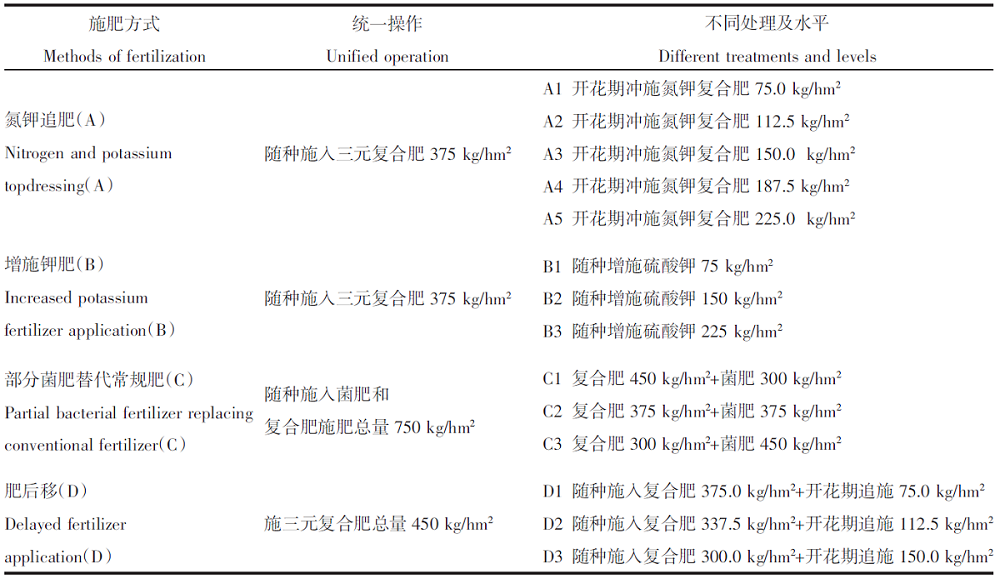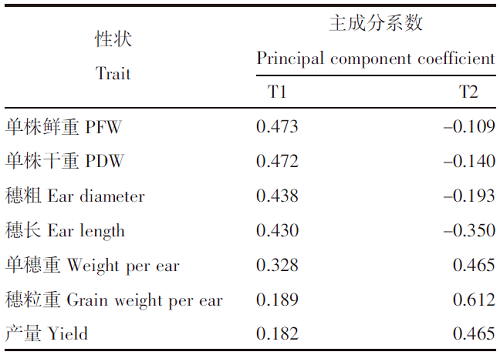北方农业学报 ›› 2023, Vol. 51 ›› Issue (4): 48-55.doi: 10.12190/j.issn.2096-1197.2023.04.06
施肥方式对谷子产量及产量性状的影响
于大伟1, 李丽君2, 李海东1, 闫立伟1, 黄硕1, 赵铁锋1, 李欣1, 洪钟1, 李小平1, 郭永鹏3
- 1.赤峰市农牧技术推广中心,内蒙古 赤峰 024000
2.内蒙古自治区农牧业技术推广中心,内蒙古 呼和浩特 010013
3.敖汉旗农牧局,内蒙古 敖汉 024300
The effect of fertilization methods on yield and yield traits of millet
YU Dawei1, LI Lijun2, LI Haidong1, YAN Liwei1, HUANG Shuo1, ZHAO Tiefeng1, LI Xin1, HONG Zhong1, LI Xiaoping1, GUO Yongpeng3
- 1. Chifeng Agriculture and Animal Husbandry Technology Promotion Center,Chifeng 024000,China
2. Inner Mongolia Agriculture and Animal Husbandry Technology Promotion Center,Hohhot 010013,China
3. Aohan Banner Agriculture and Animal Husbandry Bureau,Aohan 024300,China
摘要:
【目的】探究适宜内蒙古赤峰市谷子生产的最优施肥方式及用量。【方法】在赤峰市喀喇沁旗,以谷子品种金苗K1为试验材料,设置氮钾追肥(A)、增施钾肥(B)、部分菌肥替代常规肥(C)、肥后移(D)4种施肥方式共14个处理,对谷子产量和单株鲜重、单株干重、穗粗、穗长、单穗重、穗粒重6个产量性状进行比较;采用主成分分析法,综合评价最优施肥方式及用量。【结果】不同处理下谷子产量为3 745.7~8 236.8 kg/hm2,变异系数为20.49%。产量与单穗重、穗粒重、穗粗呈极显著正相关(P<0.01)。提取出的前2个主成分覆盖了谷子产量和产量性状83.074%的信息。综合比较分析表明,氮钾追肥有利于谷子产量的提高和产量性状的改善,播种时随种施入三元复合肥375 kg/hm2,开花期分别冲施氮钾肥225.0 kg/hm2(A5)、112.5 kg/hm2(A2)是该施肥方式下较好的2个处理;增施钾肥有利于促进谷子增产,但产量性状表现较差,播种时随种施入三元复合肥375 kg/hm2的同时增施硫酸钾225.0 kg/hm2(B3)是该施肥方式下的最佳处理;部分菌肥替代常规肥在提高谷子生物产量上表现较好,但籽粒产量水平较低,施用三元复合肥450 kg/hm2、菌肥300 kg/hm2(C1)是该施肥方式下的最佳处理;肥后移中谷子的产量和产量性状均表现较差。【结论】氮钾追肥中随种施入三元复合肥375 kg/hm2,开花期分别冲施氮钾肥225.0 kg/hm2(A5)、112.5 kg/hm2(A2)处理适宜在内蒙古赤峰市谷子生产上推广应用;部分菌肥替代常规肥中施用三元复合肥450 kg/hm2、菌肥300 kg/hm2(C1)处理适宜应用于内蒙古赤峰市以收获生物产量为主要目标的谷子生产。
中图分类号:
- S515






